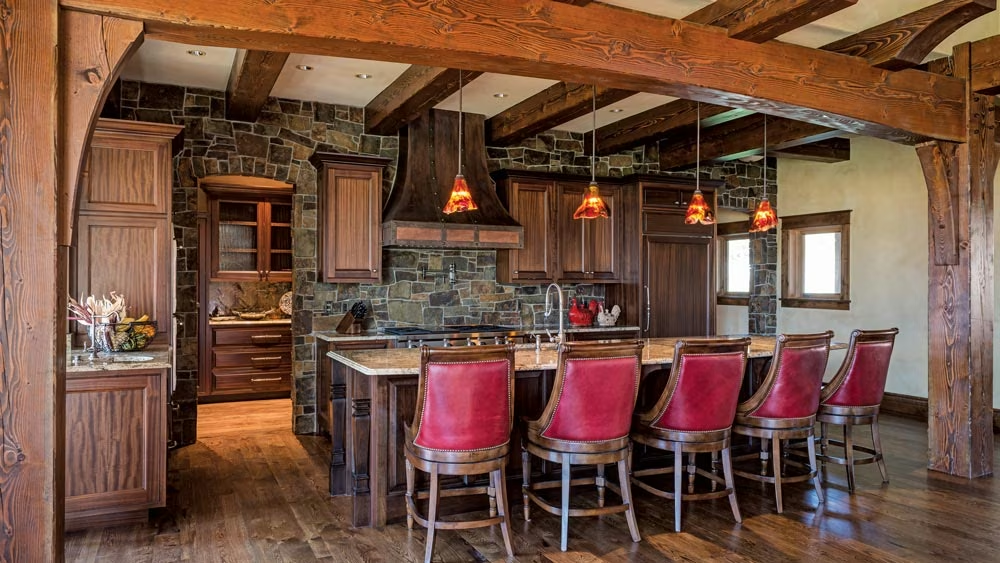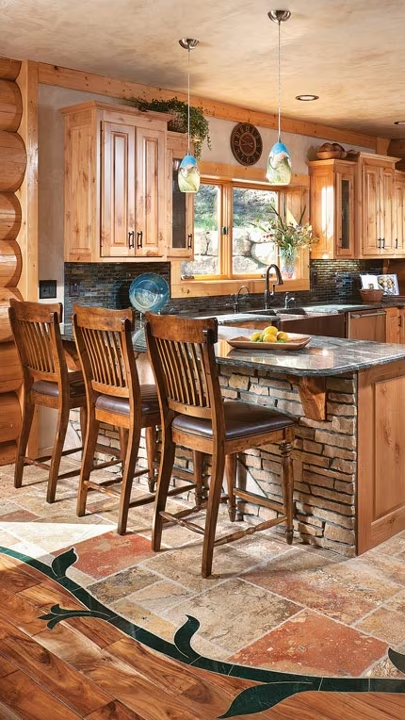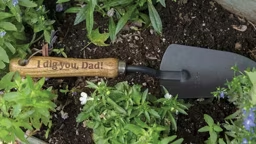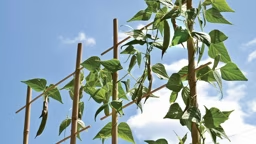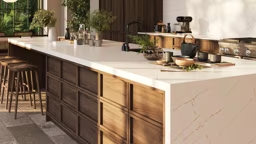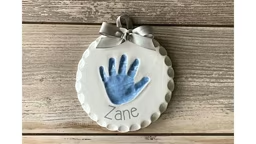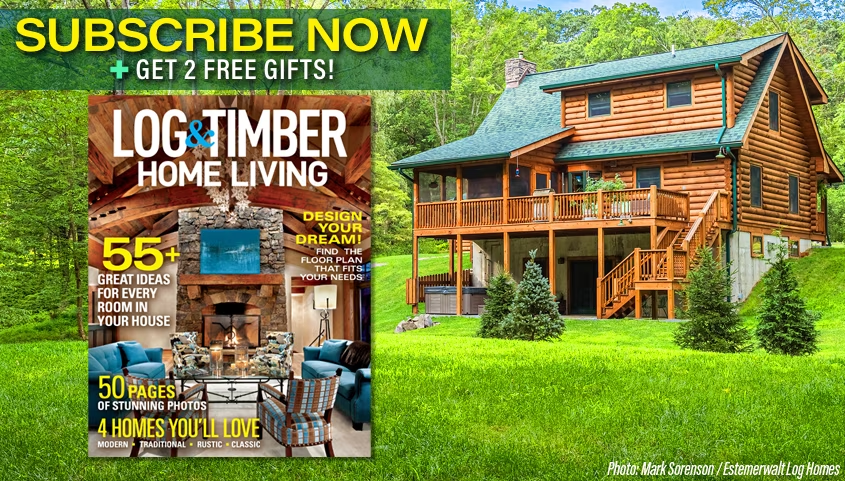FLOORS
Wood Flooring
Homeowners fall in love with wood flooring for reasons that go well beyond its beauty. Here are just a few:
- Durability. A solid wood floor can last for a century or more, thanks to a durable finish that can be easily repaired, sanded and refinished whenever it starts to wear thin.
- Warmth. Wood also offers a warm feel underfoot. Mother Nature designed this resource to be an excellent insulator. With thousands of air chambers per cubic inch, wood floors are cozier than other flooring options.
- Maintenance. Hardwood floors are a breeze to clean — and simply incorporating them into your home increases its value.
- Permanence. A vintage version of solid wood, antique or “reclaimed” floors bring instant history to a new home. Many “found” woods have been salvaged from old barns or industrial buildings. Found flooring is also quite durable and environmentally friendly, since it makes use of lumber that was discarded.
Popular Species for Wood Floors
Pine. This species is perfect for traditional timber homes but diverse enough for rustic or formal settings.
- Pros: Inexpensive; widely available
- Cons: Softer and easier to dent than other wood species
Bamboo. This tall Chinese grass is environmentally friendly; features distinctive grain that shows the “nodes” of the stalks.
- Pros: A distinctive modern look; fast-growing so it replenishes quickly
- Cons: Doesn’t sand well; very rigid, so subfloor must be perfectly flat
Douglas Fir. Popular for its straight grain, the color varies between brown and white on each board.
- Pros: Like pine, the look is perfect for wood homes, but typically has straighter grain
- Cons: Can bleach out if exposed to sunlight
Hickory/Pecan. This durable hardwood has a wavy, irregular grain and drastic color variations, even within one plank.
- Pros: Characteristics are very complementary in rustic homes
- Cons: Hardness makes it difficult to machine and sand; nails can split the tongue-and-groove planks
Oak. You’ll find a pronounced, wavy grain and a slight red tint in this classic, traditional wood.
- Pros: Elegant aesthetic that’s a natural fit in timber homes
- Cons: Slightly pricier than its chief competitor, pine
Wise Advice for Wood Floors
- If you choose solid wood floors for your home, consider a factory-applied finish, which will make installation much easier — no dust from sanding, no fumes from finishing and no waiting around for the floors to dry.
- Consider your home’s activity level when deciding on a species. In homes with kids or pets, most floors (especially American hardwoods like maple, walnut and cherry) can weather a little abuse. Softwoods, like Southern yellow pine, work too — if you’re prepared for dents and scratches to the surface over time.
- Changes in humidity can lead to squeaking and buckling. This moisture sensitivity may rule out wood floors in basements and bathrooms.
Other Flooring Options
Luxury Vinyl Plank. If the look of wood is appealing, but your log home will be busy with foot traffic via people or pets, try luxury vinyl plank, also known as LVP.
- Pros: Scuff, scratch and water resistant; some styles have textured surfaces that mimic the real deal.
- Cons: Can’t be refinished; susceptible to UV damage
Laminated Wood. This alternative wood-look option is made by placing an image of wood on top of fiberboard.
- Pros: Feels soft and warm underfoot; economical option to get the wood look
- Cons: Not as realistic as LVP
Carpet. Soft and sound absorbent, it’s a great insulator and a solid choice for bedrooms.
- Pros: Disguises subflooring irregularities, which may cause hollow sounds and varied floor heights with harder materials; inexpensive
- Cons: Only available in limited widths, so visible seams are highly possible; retains footprints and moisture, as well as traps pet dander and dust
Tile. Ceramic and porcelain tiles disguise chips and cracks well over time.
- Pros: Withstands moisture, so is great in bathrooms and mudrooms; wide selection of finishes, colors, sizes and shapes
- Cons: Not suitable for all applications as some tiles are not as moisture-absorbent as others; lighter tiles (with lighter grout) can show dirt/stains; very dark shades show dust and hair
Stone. One of the hardest, densest materials available, stone was made for high-traffic areas.
- Pros: Color tones vary between tiles, adding to the rustic aesthetic; durable enough to last a lifetime
- Cons: Porous, meaning it’s more susceptible to stains and water damage (but manufactured stone can be a lower-maintenance alternative)
HEARTHS
The perfect fireplace will add warmth (literally and figuratively) to your home. Use this guide to ignite your ideas.
Fireplace
This classic option is popular in timber homes and comes in affordable factory-built models.
- Pros: Traditional appeal; can be open on one to four sides
- Cons: Typically requires professional installation; full-masonry fireplaces require reinforced foundations to support their weight
Fireplace Insert
This insulated, closed-door system is placed in an existing wood-burning fireplace opening.
- Pros: Increases the efficiency of older fireplaces; can function as a secondary heat source
- Cons: Requires a working chimney; inserts typically must be removed for routine maintenance
Wood or Pellet Stove
Ambiance and ease of use come together in perfect harmony in this freestanding option.
- Pros: Wide range of sizes; very efficient source of heat
- Cons: Takes up space in the room; requires fireproof flooring and/or backing material
Masonry Heater
Stone mass absorbs the heat from small, hot fires, radiating warmth even after the fires are out.
- Pros: Among the cleanest and most efficient to operate
- Cons: Expensive and heavy; requires a solid foundation
Electric
Providing the warmth of a traditional heater without the need for fuel and cleanup, this option is available as a fireplace, insert or stove.
- Pros: Provides the ambiance of a fireplace; programmable heat; can be placed anywhere
- Cons: Lower-end units look artificial and lack crackling sound and aroma of an actual fire
COUNTERTOPS
Granite and other natural stones have been the countertop material of choice for a decade, but it’s no longer the final word in durability. Quartz has usurped granite’s throne, thanks to exquisite color options and extreme resistance to scratches, stains and scorching, as well as its low-maintenance practicality.
Marble offers a rich, timeless look. Its distinctive veining mixes well with both traditional and contemporary designs. Likewise, soapstone has a silky texture, and its deep shade of bluish gray looks outstanding with wood. However, both natural materials are costly and are susceptible to stains and scratches.
Concrete is clean-lined, non-fussy and fits seamlessly into rustic, modern or industrial design schemes. But forget the image of dull gray expanses. Available in a nearly unlimited array of textures, colors and patterns, concrete can even be fashioned to mimic wood or marble, but keep in mind that it must be treated with a high-performance coating to protect it from stains or acid pitting.
Butcher-block counters lend a classic warmth to a kitchen. They come in a range of wood species and styles, including plank (boards facing up), edge-grain (boards on their side) and end-grain (ends facing up). Scratches sand out easily but stains are tougher to remove. And since wood is porous, it needs frequent disinfecting to thwart bacteria growth.
CABINETRY
Just like fine furniture, cabinetry reflects the quality and craftsmanship that went into creating it. Custom cabinets can be pricey, but you can select the color, style, shape and size to fit your needs. Lower-priced options, such as stock and semi-stock, will have fewer design options but still can be attractive and affordable. Whichever you choose, look for drawers and doors that have metal operational components rather than plastic — they’ll open and close more smoothly. And take your time perusing your styles and materials; the right ones will last for years.
RECLAIMED MATERIALS
Salvaged, reclaimed and recycled materials are a perfect way to add instant historical charm to your home. Compared to new products, reclaimed items (particularly old-growth wood) are much stronger and will last longer in your home. Many reclaimed items also will require less maintenance simply because they’ve already worn over time, creating a time-honored look that’s become increasingly popular in recent years. Repurpose old timber beams as mantels; barnwood planks as flooring; iron gates as loft enclosures — see what uses you can dream up.
DOORS
In addition to your home’s windows, exterior doors can provide a preview of what’s inside or completely contrast a home’s interior; either way, they should be somewhat consistent with the exterior design, particularly in the front. Wind, humidity and extreme temperatures can cause corrosion and will damage any door on your home that’s ill equipped for harsh weather. Style decisions include everything from panel design to wood species to windows — tempered glass inserts, sidelights and custom carvings add character.
Door Styles
- Slider/Bypass Doors. Slide on a track system, bypassing another door or a wall, for access. Usually glass.
- French. Double doors that often incorporate inset glass panels and swing in or out.
- Dutch. The top half can open while the base stays closed. Great for mudrooms or as exterior doors to contain kids and pets while allowing fresh air to enter.
- Pocket. Typically used for interior doors, they save valuable space by retracting into a recessed area within a door frame.
- Barn. Similar to a pocket door, but the track mechanism is exposed, as is the door when it’s retracted. Barn doors are best used inside.
Door Construction
- Solid Wood. Wood doors offer timeless appeal and value. A true solid-wood door is often used at the front entry, as it can include eye-catching architectural details, such as intricate carvings. Solid-wood doors are durable when protected against the elements and provide strong insulation against heat, cold and sound.
- Solid Core. Made with a core of composite wood (such as MDF), solid-core doors are finished with layers of veneer, which can be stained or painted. Because of their construction, solid-core doors are heavy and must be installed properly to avoid sagging. They’re less commonly used than their hollow- core counterparts due to their cost (about 50 percent more) but are popular for rooms where sound dampening is desired, such as a home office.
- Hollow Core. The least expensive option in the door market, hollow-core doors are filled with a cardboard-type center, are lightweight and, as a result, are easy to install. Most commonly used in bedrooms, bathrooms and closets, these doors are less likely to warp with moisture and temperature changes than their solid-core cousins, but they are prone to wear and tear and offer minimal sound resistance.
- Metal. Sturdy, strong and durable, metal doors are comprised of thin sheets of steel surrounding a polyurethane-foam core. Metal doors are both fire and noise resistant, making them safe choices for garage access inside the home. These doors must be maintained to prevent rust, and they have minimal insulating properties.
WINDOWS
With an average lifespan of 20 years, windows stick around your house for quite some time. The good news is that windows are more energy efficient and available in a greater number of styles and materials than ever before. The bad news is that means there’s even more to keep track of when it comes to choosing them. The secret to buying great windows is preparation. Here’s a rundown of what you need to know.
Single-Hung
Single-hung windows are the most common. They’re named that because only the bottom sash opens, while the top sash is fixed in place.
- Pros: Simple to operate; least expensive; so common that they are available in virtually any size or material
- Cons: Prone to sticking; lack some of the advantages of more elaborate window styles
Double-Hung
Double-hung windows look like the single-hung variety, but both the bottom and top sash can open.
- Pros: Freedom of opening either sash, which enhances air flow and is safer for children or pets; tilt-in sashes make for easy cleaning
- Cons: Higher price for convenience
Slider
As the name suggests, these panels slide open horizontally rather than raise vertically. Imagine a double- or single-hung window turned on its side, and you’ve got a slider.
- Pros: Create a good seal for energy-efficiency; easier to open than double- or single-hung windows
- Cons: Not available in as many sizes or materials; don’t allow in as much fresh air as other options
Casement
Casement windows are hinged at the side (their cousins, awning windows, places the hinge at the top) and crank open, usually to a full 90 degrees.
- Pros: Easiest to operate; offer the best views; allow the most airflow and create the tightest seal
- Cons: Can get damaged if left open in the rain; not a good choice for high-traffic areas like decks and patios
Windows + Energy Efficiency
You not only want your windows to add to your timber home’s curb appeal, you need them to create a weather-tight, energy-efficient space. Look to these options for extra energy savings:
- Triple/quad glazing. Three to four panes (layers) of glass provide added insulation from the weather outside. As a rule, the more layers you have, the better the protection (and the lower your energy bills will be).
- Low-E coatings. Low-emissivity coatings employ a silver film, thinner than a human hair, that reflects heat. In the summer, it keeps the heat from penetrating your home, and in the winter, it bounces the generated heat inward, rather than letting it escape through the glass.
- Gas fills. The cavities between panes of glass are filled with gas (typically argon, but krypton and xenon gas also may be used), creating a dense but invisible layer of thermal resistance. Gas fills are often used in conjunction with low-E coatings.
STAINS
When choosing a stain for your timber frame, nothing says you have to select a shade of brown. As you’re shopping, you’ll find a plethora of pigments from which to choose, and as long as you love it, there is no wrong answer when it comes to color. However, there are a few things to keep in mind while researching the type of stain you buy.
There are two major varieties in the timber home stain and sealant world:water-based and oil-based. Each has its pros and cons.
- Water-based stains are generally odorless, less labor-intensive to apply and easy to clean up with soap and water. Water-based stains and sealants also dry quickly when applied, which seems like a good thing unless you have to walk away from the project and come back to it. The fast-drying application can result in visible stop/start marks and brush strokes.
- Oil-based stains enjoy a reputation of having rich, deep tones that can be more difficult to achieve with their water-based counterparts. They also repel water, making them a great option for exterior applications. But oil-based products often have a strong odor and require special solvent at cleanup. And because oil-based stains penetrate deeply into the wood, it can require more coats to achieve the desired effect.
In an effort to protect the environment and create healthier homes both water- and oil-based manufacturers have formulated low-VOC products that comply with EPA regulations. Many also contain additives to protect against mold, mildew and insects.
Whichever you choose, make sure you select a product designed for heavy timbers. The type of stain you’d buy to finish a deck or even furniture isn’t adequate to stain, seal and protect your timber frame.
ROOFING
Roofs protect interior spaces that have been inspired by years of preparation, and their pitches give a house its dimension. And yet we often don’t consider roofing material until our design team or builder brings it up. In actuality, your roof should be on the short list of decisions to make during the planning phase.
But roofing options (just like most finishes for the home) can be overwhelming. To get started, check out online photo galleries, clip pictures from magazines and envision the roof you’d like to have for your future home. In addition to looks, consider the characteristics and benefits of each material. A closer look at four of the top roofing options may reveal what’s right for you.
Asphalt Shingles
Asphalt shingles are the most common material used on roofs today, primarily because they are affordable and don’t require much maintenance, not to mention they come in a variety of colors and styles. The downside? Because they’re lightweight, they can blow off during high winds, and they tend to degrade faster in regions with high solar exposure, such as the Southwest or Florida. Being so susceptible to nature’s forces also means composite shingles tend to have shorter lifespans than other materials used on timber home roofs.
Slate
A slate roof is made of slices of rock cut to the size of standard shingles. Like wood shakes, slate has a natural appearance and comes in many sizes and colors. But slate is immune to damage caused by rot or insects, and it serves as good fire protection. Although it requires little maintenance, slate comes at a price. Because it’s heavy, some homes require additional roof support, which can get costly. Additionally, slate slabs are breakable and should not be walked on by a non-professional, a potential problem in gutter-cleaning season.
Metal
From weathered copper to rusted corrugated metal to painted standing-seam panels, metal roofs are a classic way to top a timber home. The type of metal you choose has a direct relationship with the style of your house but rest assured that this is an option that will last a very long time. It’s also the only material that creates a symphony of sound in a rain shower.
Wood Shakes
With wood shakes, a homeowner can choose from a variety of species, as well as the width and thickness of the shake. Though considered by many consumers to be an upper-end material, cedar shakes and shingles can be less expensive than tile, metal or slate, and they provide good insulation while also allowing for air circulation. As a natural material, however, wood shakes are vulnerable to rot, mildew, mold and insects. Routine maintenance, such as sealing, inspection and replacement, is required to keep a wood-shake roof in good shape.
Clay
With impressive abilities to create cool, comfortable interiors, clay roofing has been used for centuries. Besides helping reduce energy bills, clay is sustainable. Once handcrafted, today’s tiles are machine molded, kiln-fired and sealed to reduce moisture absorption. And, while traditional terra-cotta, barrel-style tiles may come to mind when you think of a clay roof, many other looks are available. For example, tiles can be made to mimic slate or shakes. No matter the style though, they are labor-intensive to install due to their weight.




